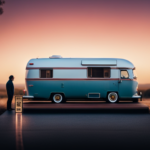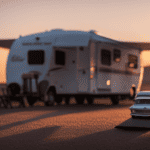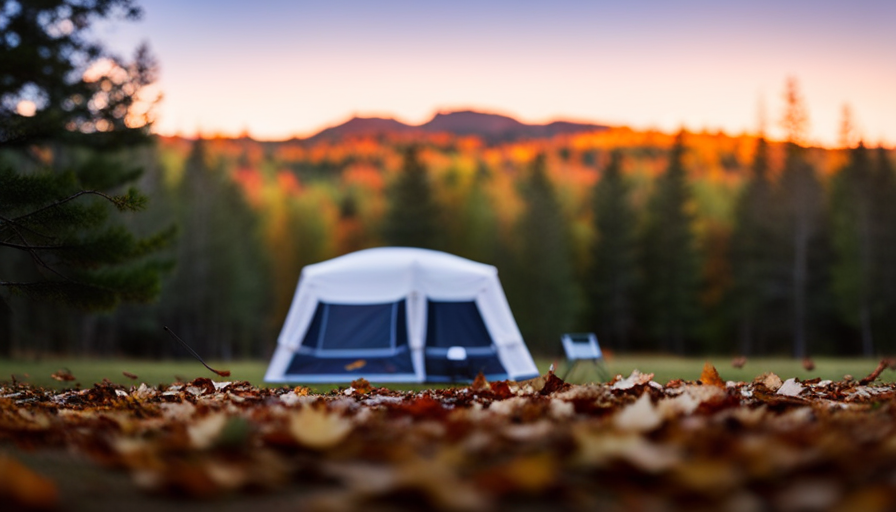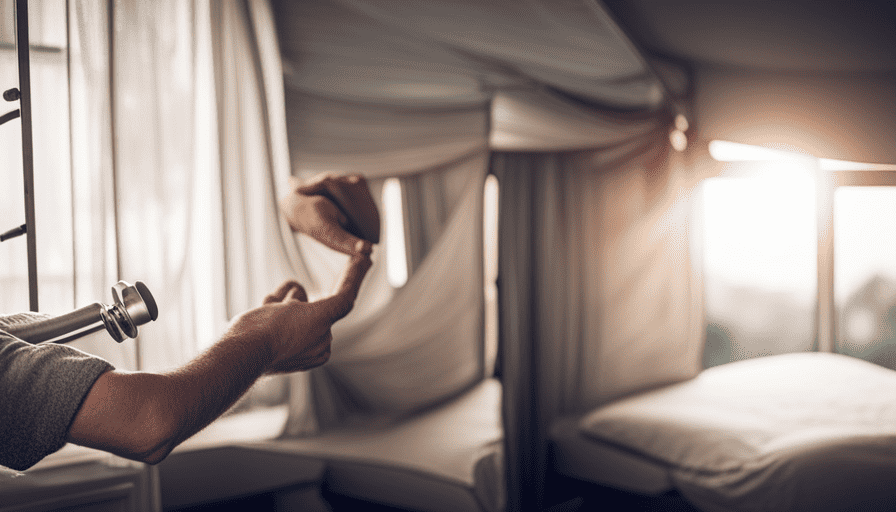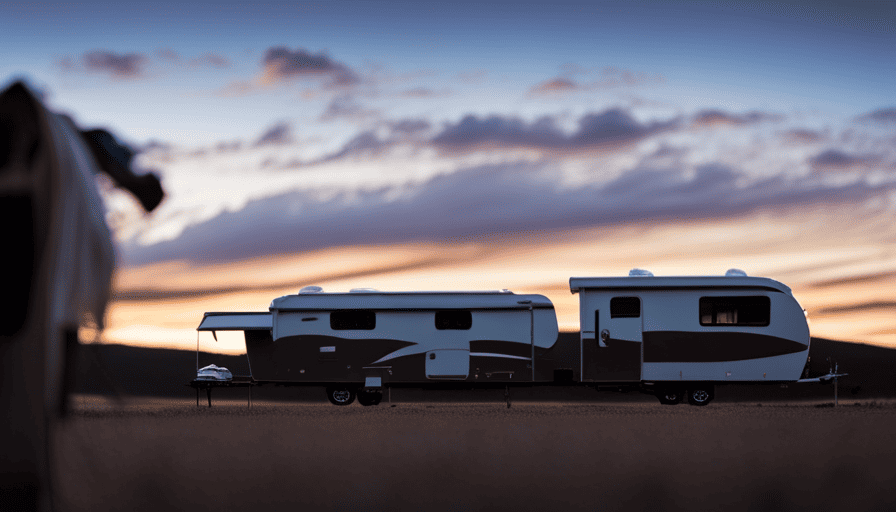Ah, the beauty of nature! The scent of fresh air, the melody of birds singing, and the sense of liberation as you set off on your camping journey. However, before you head out with your reliable camper, there’s one crucial detail you must keep in mind: its dry weight.
Now, you might be thinking, ‘Dry weight? What’s the big deal?’ Well, my fellow campers, let me tell you, understanding the dry weight of your camper is crucial for a smooth and stress-free camping experience. It’s like knowing the exact ingredients of a recipe before you start cooking – it ensures that everything will turn out just right.
In this article, we’ll delve into the world of dry weight, exploring its definition, significance, and how to calculate it. So buckle up, grab a cup of coffee, and get ready to become a dry weight expert. Happy camping!
Key Takeaways
- Dry weight refers to the weight of a camper without water, supplies, or personal belongings.
- Knowing the dry weight is important for fuel efficiency and camper stability.
- Overloading a camper can lead to safety hazards and potential damage.
- Understanding the relationship between dry weight and towing capacity is important for selecting the right camper and preventing accidents.
Definition of Dry Weight in the Camping Context
Dry weight, in the camping world, refers to the weight of a camper without any water, supplies, or personal belongings loaded inside. It is important to know the dry weight of a camper for several reasons.
One of the main reasons is fuel efficiency. The heavier the camper, the more fuel it will require to tow it. By knowing the dry weight, campers can estimate how much fuel they’ll need for their trips, helping them plan accordingly and avoid running out of fuel in the middle of nowhere.
Another important factor affected by the dry weight is camper stability. The weight distribution plays a crucial role in how stable the camper is on the road. If the camper is too heavy on one side, it can lead to swaying and loss of control while towing. Therefore, it’s essential to know the dry weight in order to properly distribute the load and ensure a safe and stable journey.
Knowing the dry weight of a camper is vital for both fuel efficiency and overall stability. This information allows campers to make informed decisions about their trips and ensure a smooth and enjoyable camping experience. By understanding the significance of dry weight, campers can have peace of mind and focus on creating lasting memories in the great outdoors.
Importance of Knowing the Dry Weight of a Camper
Understanding the exact mass of a camper during travel is crucial for safe navigation and optimal performance. When it comes to campers, two important weight measurements to consider are the dry weight and the gross weight.
The dry weight refers to the weight of the camper without any additional items, such as water, propane, or personal belongings. On the other hand, the gross weight is the total weight of the camper, including all its contents.
Knowing the dry weight of a camper is essential for several reasons. Firstly, it allows you to determine the amount of cargo you can safely load into the camper without exceeding its weight capacity. This is important to prevent any damages or accidents that could occur from overloading.
Additionally, being aware of the dry weight helps you calculate the amount of fuel needed for your journey. Heavier campers require more fuel, so understanding the dry weight can help you plan your trips more efficiently and save on fuel costs.
As we transition into the next section about the components included in the dry weight calculation, it is important to note that knowing the dry weight is just the first step in understanding the overall weight of your camper.
Components Included in the Dry Weight Calculation
Transitioning into the components that make up the weight calculation, it’s important to note that discovering the dry weight is merely scratching the surface of understanding the true heft of your mobile home.
There are several factors affecting the dry weight of a camper that you should be aware of. Firstly, the materials used in the construction of the camper play a significant role. Lightweight materials such as aluminum or fiberglass will result in a lower dry weight compared to heavier materials like wood.
Additionally, the size and layout of the camper can impact its weight. Larger campers with more amenities and storage space will naturally weigh more than smaller, more minimalist models.
When it comes to managing the weight of your camper, there are a few tips to keep in mind. Firstly, it’s essential to know the weight capacity of your vehicle and ensure that your camper falls within that limit. Overloading your vehicle can lead to safety hazards and potential damage to both your camper and vehicle.
Secondly, consider the weight distribution within your camper. Properly distributing the weight can improve stability and handling while on the road. Lastly, be mindful of the items you pack in your camper. Only bring what you truly need to avoid unnecessary weight.
Understanding the components that contribute to the dry weight of your camper is crucial for safe and efficient travel. Now that we’ve covered the factors affecting the dry weight, let’s delve into how to find the dry weight of a camper.
How to Find the Dry Weight of a Camper
To accurately determine the true heft of your mobile home, you can easily find the weight of your camper by following these steps.
First, consult the manufacturer’s documentation. The dry weight specifications are typically listed in the owner’s manual or on the manufacturer’s website. This information provides an estimate of the weight of the camper before any additional items are added.
If you’re unable to find the dry weight specifications from the manufacturer, you can calculate the dry weight accurately yourself. Empty your camper of all personal belongings, fuel, water, and waste. Then, take your camper to a certified weighing station, such as a truck stop or RV dealership. Make sure the camper is level and the weight is evenly distributed on all tires. Weigh each axle separately to get an accurate measurement.
By finding the dry weight specifications or calculating it accurately, you can have a better understanding of the weight capacity of your camper. This knowledge is important as it helps you determine if your vehicle is capable of towing the camper safely.
Now, let’s explore the factors that can affect the dry weight of a camper.
Factors Affecting the Dry Weight of a Camper
The heft of your mobile home can be influenced by various factors, such as the materials used, additional features, and personal customization choices. These factors can significantly impact the dry weight of a camper, which ultimately affects its fuel efficiency and overall cost.
Here are three key factors that can affect the dry weight of a camper:
-
Construction materials: The type of materials used in building the camper, such as aluminum, fiberglass, or wood, can greatly impact its weight. Lighter materials like aluminum can reduce the overall weight of the camper, leading to better fuel efficiency.
-
Additional features: Extra amenities like slide-outs, awnings, and larger tanks for water and propane can add significant weight to the camper. While these features enhance comfort and convenience, they also increase the overall weight, potentially reducing fuel efficiency.
-
Personal customization choices: When purchasing a camper, you have the option to choose additional customizations, such as upgraded appliances or furniture. These choices can add weight to the camper, affecting both fuel efficiency and overall cost.
Understanding the relationship between dry weight and towing capacity will help you make informed decisions when it comes to selecting the right camper for your needs.
Understanding the Relationship Between Dry Weight and Towing Capacity
When it comes to towing a camper, it’s crucial to understand the relationship between dry weight and towing capacity. We need to ensure compatibility with our towing vehicle to prevent any potential issues on the road.
Overloading the camper can lead to safety risks, so it’s important to know the limits and not exceed them.
Ensuring Compatibility with Towing Vehicle
Make sure your towing vehicle can handle the dry weight of the camper, as exceeding the weight limit can increase the risk of accidents by 45%. It’s crucial to ensure proper hitch installation to securely attach the camper to the towing vehicle. A poorly installed hitch can result in instability and sway while driving, making it dangerous for both you and other motorists on the road.
Additionally, it’s important to consider the impact of the camper’s weight on fuel efficiency. Towing a heavier camper requires more power and fuel, which can significantly reduce your vehicle’s mileage. By understanding the weight limitations of your towing vehicle and choosing a camper that falls within those limits, you can prevent overloading and reduce safety risks.
Transitioning to the next section, let’s explore some steps to prevent overloading and ensure a safe towing experience.
Preventing Overloading and Safety Risks
To ensure compatibility with your towing vehicle, it’s crucial to understand the dry weight of your camper. This weight refers to the mass of the camper without any additional cargo, water, or fuel. By knowing this information, you can prevent overloading and potential safety risks during your travels.
When it comes to preventing overloading risks, there are important safety precautions to follow:
- Regularly check the weight rating of your towing vehicle and ensure it can handle the dry weight of your camper.
- Distribute the weight evenly in the camper to maintain stability and balance while on the road.
- Avoid exceeding the weight limits specified by the manufacturer to prevent damage to the vehicle and ensure safe handling.
- Consider using weight distribution hitches or sway control devices for added stability and control.
By adhering to these safety precautions, you can reduce the risks associated with overloading and enjoy a safer camping experience.
Next, we’ll explore some helpful tips for managing and reducing the dry weight of your camper.
Tips for Managing and Reducing Dry Weight
When it comes to managing and reducing dry weight in a camper, there are a few key tips to keep in mind.
First, packing light and efficiently is essential. This means only bringing the necessary items and finding creative ways to save space.
Additionally, considering lightweight materials and features can make a significant difference. Opting for lighter materials for furniture, appliances, and accessories can help reduce overall weight without sacrificing functionality.
By following these tips, we can ensure a lighter, more efficient camper experience.
Packing Light and Efficiently
Pack light and efficiently by focusing on the dry weight of your camper, allowing you to travel effortlessly and enjoy your journey to the fullest. To achieve this, consider the following packing tips and weight distribution techniques:
- Organize your belongings into separate categories to maximize space and reduce clutter.
- Utilize storage compartments and overhead cabinets to keep items secure and easily accessible.
- Pack heavier items closer to the center of the camper to maintain stability and balance while on the road.
By paying attention to these details, you can ensure a smoother and more enjoyable travel experience.
In the next section, we’ll explore the benefits of considering lightweight materials and features, which further enhance your ability to pack efficiently and reduce overall weight.
Considering Lightweight Materials and Features
By considering lightweight materials and features, you can effortlessly enhance your ability to efficiently pack and reduce the overall weight of your belongings, allowing for a more enjoyable and stress-free travel experience.
When it comes to campers, using lightweight materials such as aluminum or fiberglass can significantly decrease the overall weight of the vehicle. These materials not only contribute to fuel efficiency but also make towing easier.
Additionally, opting for lightweight features like compact furniture, collapsible tables, and foldable beds can further reduce the weight of your camper. By incorporating these lightweight materials and features, you can maximize the space inside your camper while minimizing the strain on your vehicle.
Now, let’s address some common misconceptions about dry weight and how it relates to camper weight distribution.
Common Misconceptions About Dry Weight
One common misconception about dry weight on a camper is that it includes all the necessary equipment, but in reality, it only represents the weight of the empty vehicle itself.
Many people mistakenly believe that the dry weight includes items such as furniture, appliances, and personal belongings. However, this is not the case. The dry weight is calculated by weighing the camper without any fluids, including water, propane, or fuel.
It is important to understand this distinction because it affects the overall towing capacity of your vehicle and the amount of additional weight you can safely add to the camper.
Several factors can affect the dry weight of a camper. These include the size and construction materials of the camper, as well as any optional features or upgrades.
For example, campers made with lightweight materials like fiberglass or aluminum will have a lower dry weight compared to those made with heavier materials like wood. Additionally, larger campers with more amenities, such as slide-outs or multiple axles, will generally have a higher dry weight.
Understanding the true dry weight of your camper is crucial for safe towing. Ignoring the dry weight specifications can lead to serious consequences, such as exceeding the towing capacity of your vehicle, causing damage to the camper or tow vehicle, or compromising your safety on the road.
Therefore, it is essential to carefully consider the dry weight and its implications when selecting a camper and planning your trips.
Consequences of Ignoring Dry Weight Specifications
Ignoring the specifications for the weight of your camper can have serious consequences, putting you at risk of exceeding your vehicle’s towing capacity and potentially causing damage or accidents on the road. When you ignore dry weight specifications, you run the risk of placing too much strain on your towing vehicle. This can lead to mechanical issues, such as engine overheating, transmission failure, or brake problems. Not only does this put you and your passengers in danger, but it can also result in costly repairs.
Furthermore, ignoring dry weight specifications can increase the risk of accidents. When your towing vehicle is struggling to handle the weight of the camper, it becomes more difficult to control and maneuver on the road. This can lead to swaying, fishtailing, or even jackknifing situations, which can be extremely dangerous for you and other drivers.
In addition to the potential damage to your towing vehicle and increased risk of accidents, ignoring dry weight specifications can also affect the overall camping experience. An overloaded camper can lead to discomfort and instability inside, making it difficult to relax and enjoy your trip.
Understanding and calculating the dry weight of your camper is crucial for a smooth camping experience. By ensuring that you stay within the recommended weight limits, you can prevent potential damage to your towing vehicle, reduce the risk of accidents, and have a more enjoyable time on the road.
Conclusion: Importance of Understanding and Calculating Dry Weight for a Smooth Camping Experience
Understanding and calculating the weight of your camper is essential for a seamless and enjoyable camping trip experience. It is important to have accurate measurements of the dry weight of your camper because it directly impacts several aspects of your trip, including fuel efficiency.
Knowing the dry weight of your camper allows you to determine if your vehicle is capable of towing it safely. Exceeding the weight limits of your vehicle can put unnecessary strain on the engine, brakes, and suspension, potentially leading to accidents or breakdowns. Additionally, towing a camper that is too heavy can result in decreased fuel efficiency, causing you to spend more money on gas and limiting the distance you can travel on a single tank.
By accurately calculating the dry weight of your camper, you can also plan and pack accordingly. Knowing the weight of your camper helps you distribute the load evenly, preventing any issues with weight distribution that can affect the stability and handling of your vehicle. It also allows you to estimate the total weight of your camping gear and supplies, ensuring that you don’t exceed any weight limits imposed by your camper or vehicle.
Understanding and calculating the dry weight of your camper is crucial for a smooth and hassle-free camping experience. Accurate measurements not only ensure your safety on the road but also play a significant role in optimizing fuel efficiency. So, before you embark on your next camping adventure, take the time to weigh your camper properly – it’ll make a world of difference!
Frequently Asked Questions
What are some common mistakes people make when calculating the dry weight of a camper?
When it comes to calculating the dry weight of a camper, there are some common mistakes that people often make. One interesting statistic to note is that approximately 30% of camper owners incorrectly estimate the dry weight of their vehicles. These mistakes can be attributed to various factors affecting the dry weight, such as not accounting for additional accessories, fluids, or personal belongings.
It’s important to carefully consider these factors to ensure accurate calculations.
Can the dry weight of a camper change over time?
Yes, the dry weight of a camper can change over time due to various factors affecting its weight. Factors such as additions or modifications made to the camper, including the installation of new equipment or accessories, can increase its weight.
Additionally, changes in the camper’s structure or materials used can also impact its dry weight. It’s important to regularly re-calculate the dry weight to ensure accurate towing and avoid any potential safety issues.
Are there any legal implications of towing a camper that exceeds its dry weight?
When it comes to towing a camper that exceeds its dry weight, there can be some legal implications and safety concerns to consider.
From a legal standpoint, many states have specific regulations regarding maximum weight limits for towing. Going over these limits can result in fines, penalties, or even having your license suspended.
Additionally, exceeding the dry weight can lead to safety issues such as reduced control, increased stopping distance, and potential damage to the camper or towing vehicle.
It’s important to always abide by the legal requirements and prioritize safety when towing a camper.
How does the dry weight of a camper affect fuel efficiency?
The dry weight of a camper plays a significant role in determining its fuel efficiency. When calculating the dry weight, which excludes any additional weight such as water, fuel, or personal belongings, we can get a better idea of how much weight the vehicle is designed to carry.
Adding extra weight to the camper, such as supplies or equipment, can increase drag and put more strain on the engine, resulting in decreased fuel efficiency. Therefore, it’s important to carefully consider the impact of additional weight on fuel consumption.
What are some alternative ways to reduce the dry weight of a camper without sacrificing essential components?
To increase the dry weight of a camper without sacrificing essential components, one option is to use lighter materials. For example, replacing heavy wooden cabinets with aluminum ones can significantly reduce weight. This approach has both pros and cons.
On the positive side, a lighter camper will have better fuel efficiency and be easier to tow. However, lighter materials may be less durable and may not provide the same level of insulation as heavier ones.
Conclusion
So there you have it, folks! The importance of understanding and calculating the dry weight of your camper cannot be overstated.
It’s not just some arbitrary number that manufacturers throw around to confuse us (although it sometimes feels that way). No, knowing the dry weight is essential for a smooth camping experience.
It helps us determine if our vehicle can handle the load, prevents us from overpacking, and ensures our safety on the road. So next time you’re planning a camping trip, don’t ignore the dry weight specifications. Trust me, you’ll thank me later.
Happy camping!




